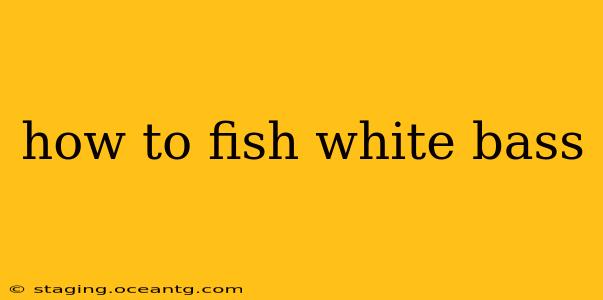White bass, with their aggressive feeding habits and impressive fight, are a favorite target for anglers of all skill levels. Whether you're a seasoned pro or just starting out, mastering the art of white bass fishing requires understanding their behavior, preferred habitats, and the best techniques to lure them in. This guide will cover everything you need to know to successfully reel in these feisty fish.
What are the best lures for white bass?
White bass are opportunistic feeders, readily striking at a variety of lures. Their preference often depends on the season and water conditions. However, some consistently effective lures include:
- Inline spinners: These create a flashy, vibrating action that attracts white bass from a distance. Popular choices include the Rooster Tail and Mepps Aglia.
- Spoons: Cast and retrieved quickly, spoons imitate fleeing baitfish, triggering aggressive strikes. Try different sizes and colors to see what works best in your location.
- Crankbaits: These diving lures mimic injured baitfish, and their erratic movements can be irresistible to white bass. Choose models that run at various depths depending on where the fish are holding.
- Topwater lures: During low-light conditions or when white bass are actively feeding near the surface, poppers and chuggers can be incredibly effective. The sound and action of these lures create a feeding frenzy.
- Jigs: Jigging with small jigs tipped with a grub or minnow imitation can be highly productive, especially near structure.
What are the best times to fish for white bass?
White bass are most active during periods of low light – dawn and dusk – and often feed aggressively during these times. However, they can be caught throughout the day, especially when they are actively schooling. Summer months often find them deeper in the water column, while spring and fall can bring them closer to the surface. Consider weather patterns too; overcast days or periods of rain can trigger feeding frenzies.
What is the best bait for white bass?
While artificial lures are highly effective, live bait can also be a powerful weapon in your white bass arsenal. Popular choices include:
- Minnows: Small minnows are a natural food source for white bass and often result in strong strikes.
- Worms: Small plastic worms or live nightcrawlers can be very effective, especially when fished near bottom structure.
- Grubs: These soft plastic lures, often rigged on a jig head, imitate small baitfish and are excellent for vertical jigging.
Where do white bass live?
White bass prefer clear, flowing waters with plenty of structure. They can be found in rivers, lakes, and reservoirs, often congregating near:
- Points and shorelines: These areas offer ambush points for hunting baitfish.
- Dams and bridges: The current changes and structure around these features attract baitfish, and therefore, white bass.
- Drop-offs and ledges: These areas provide a change in depth and water flow, creating ideal hunting grounds.
- Weed beds: White bass use weed beds for cover and to ambush prey.
What is the best technique for catching white bass?
The most effective technique depends on the location and the fish's activity level. Here are a few common strategies:
- Casting and retrieving: This is a versatile technique suitable for a wide range of lures. Experiment with different retrieves – fast, slow, erratic – to find what the white bass prefer.
- Jigging: This technique involves dropping a jig to the bottom and then rapidly lifting and dropping it to attract attention. This works particularly well near structure or in deeper water.
- Trolling: Trolling allows you to cover a larger area and is effective when white bass are schooling in open water.
- Drift fishing: Letting your bait drift naturally with the current can be highly effective in slower-moving waters.
What size hook should I use for white bass?
The appropriate hook size depends on the size of the bait or lure you're using. Generally, a size 2 to 6 hook is suitable for most white bass fishing scenarios. Match the hook size to the bait to ensure a secure and effective hookset.
What is the legal limit for white bass?
Fishing regulations vary significantly depending on location. Check your local fishing regulations to confirm the daily bag limit and size restrictions for white bass in your area. Always practice responsible fishing and adhere to all local rules and regulations. Protecting this valuable resource is crucial for future generations of anglers.
This comprehensive guide provides a solid foundation for successful white bass fishing. Remember that practice, patience, and adapting to changing conditions are key to mastering this exciting and rewarding pursuit. Tight lines!
